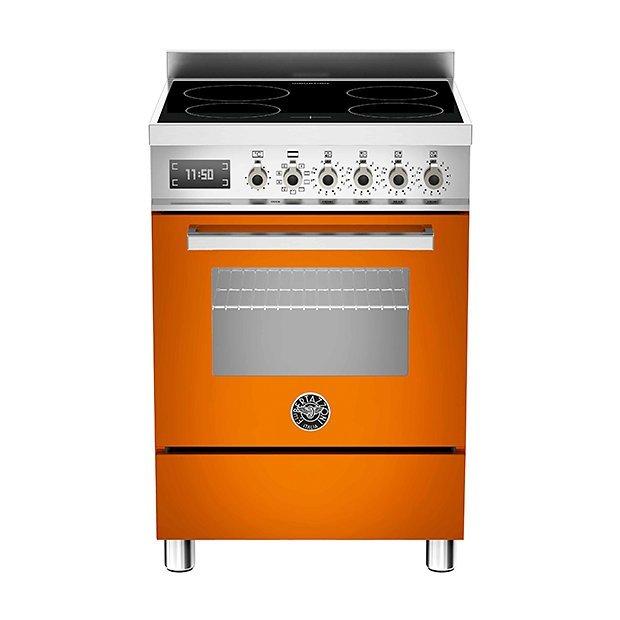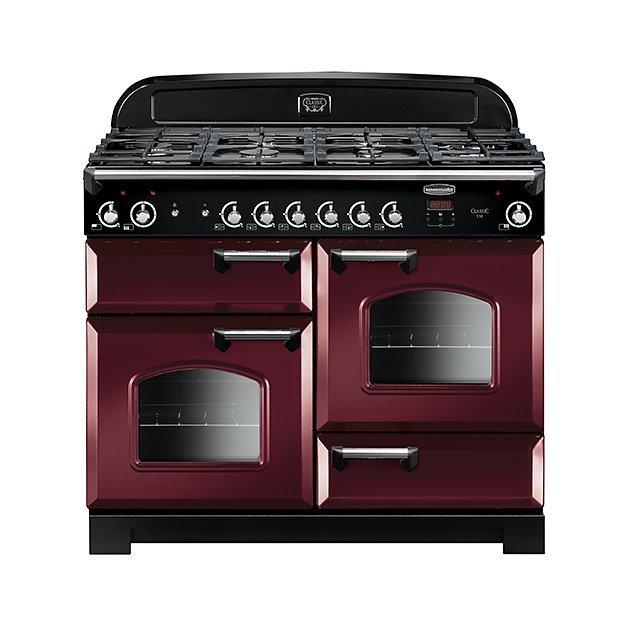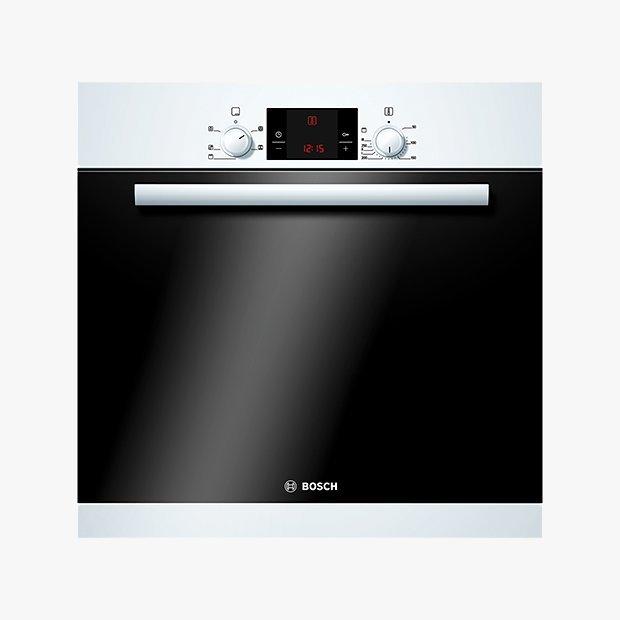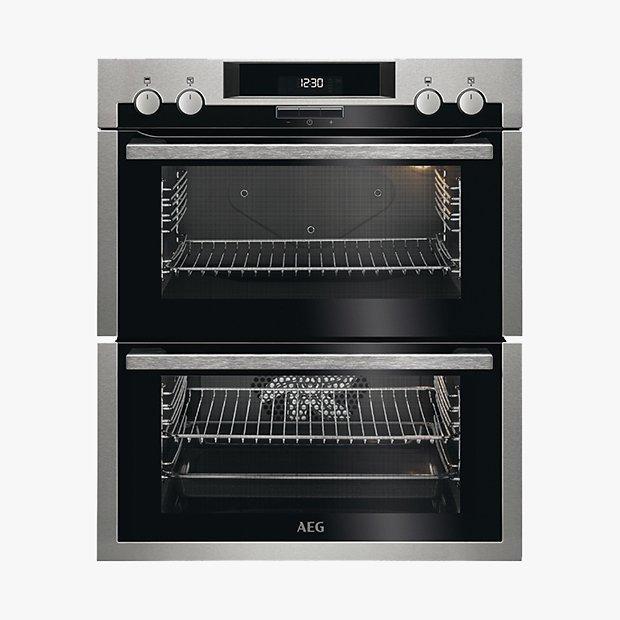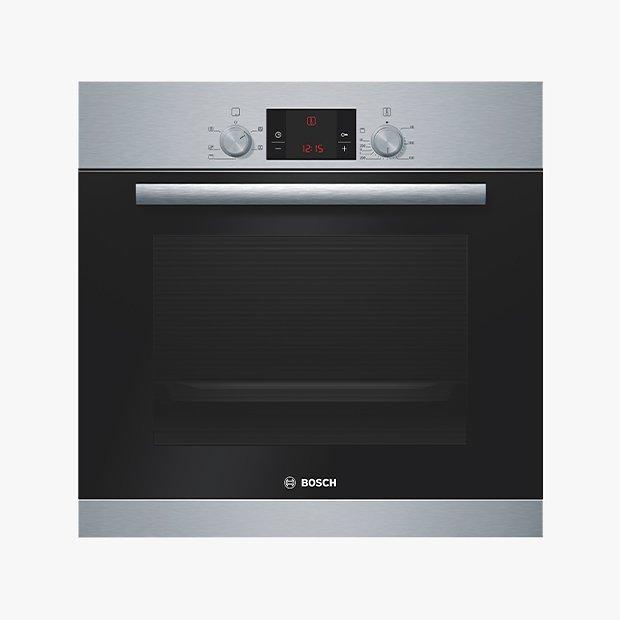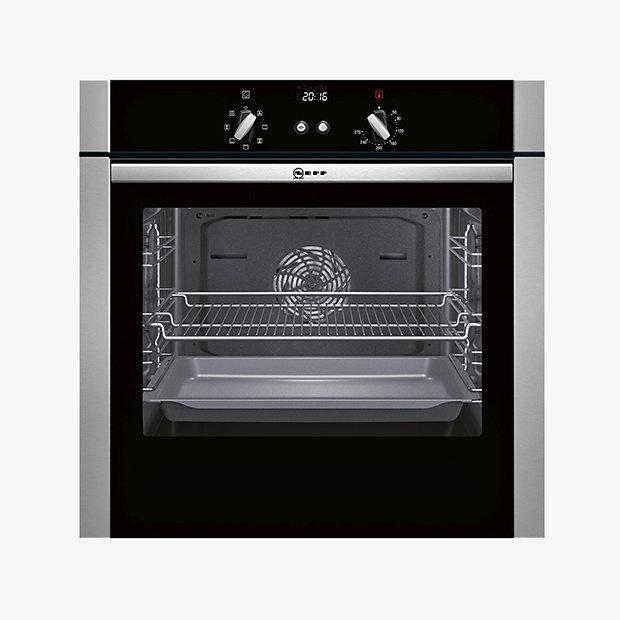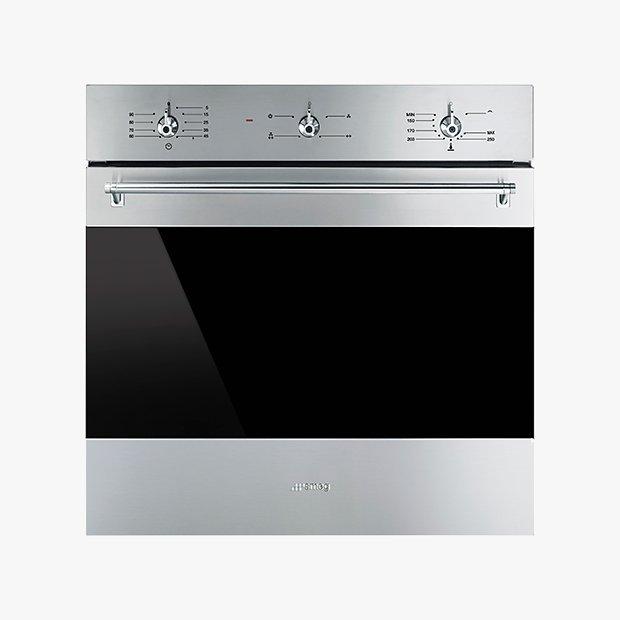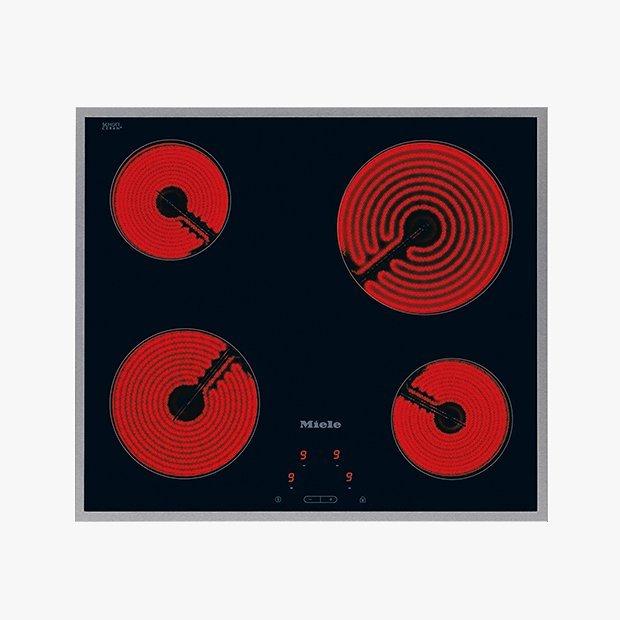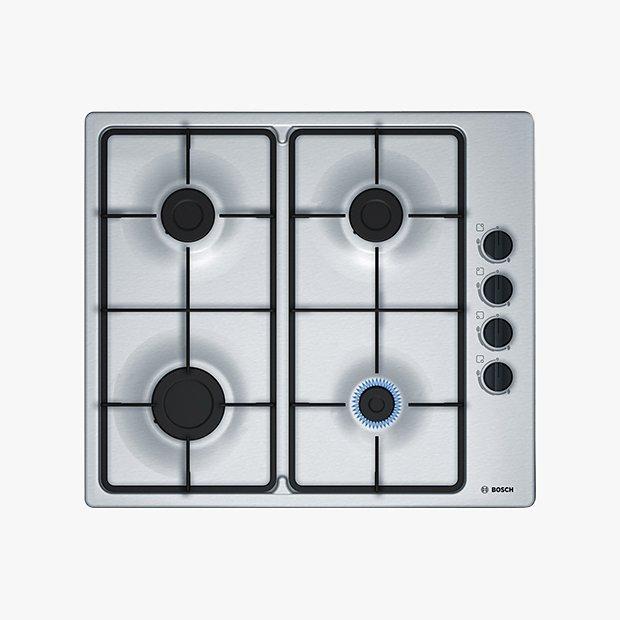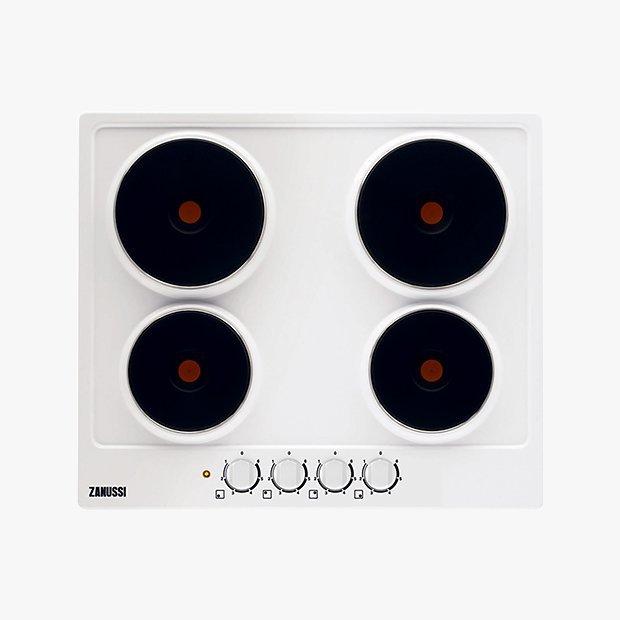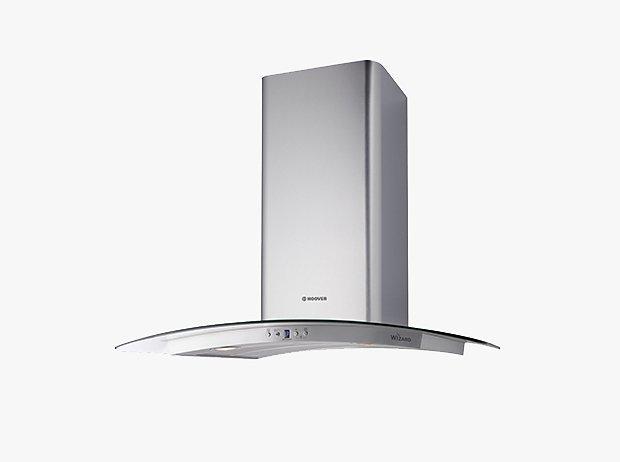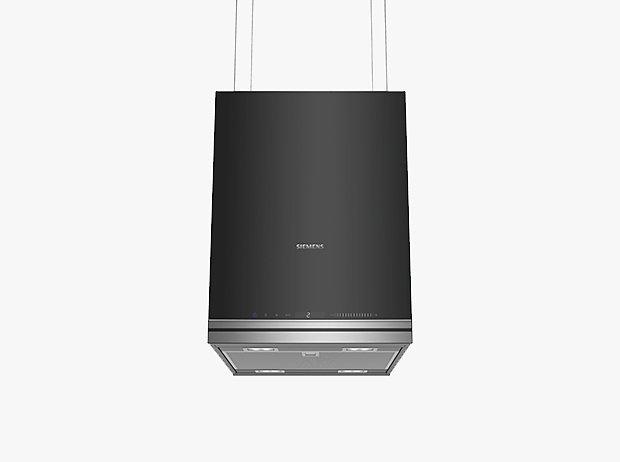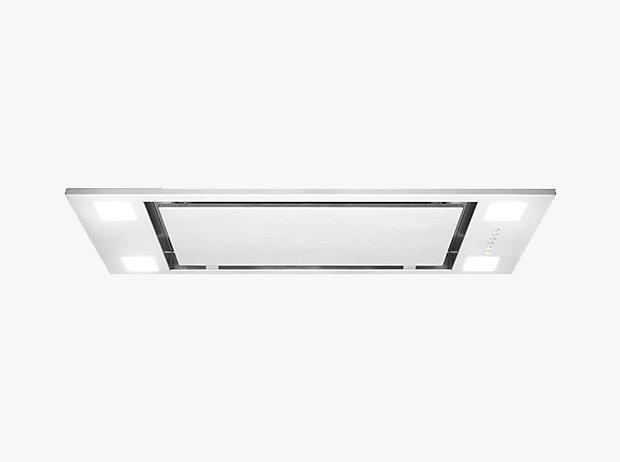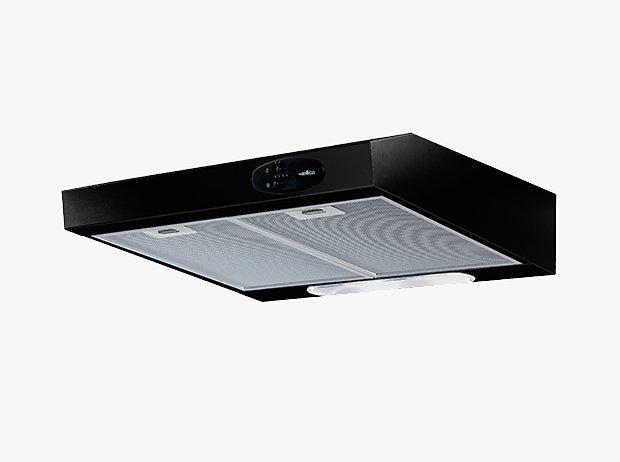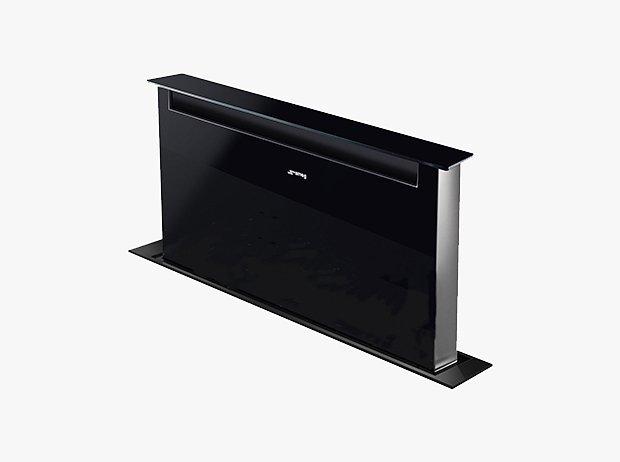Buying Guides

Buying Cookers, Ovens & Hobs
Your cooking appliance is at the heart of your kitchen, so you'll want to find one that suits your lifestyle and kitchen design. Our guide will help you choose.
And, depending on the fuel type, we can install your new appliance when we deliver it, and dispose of your old one responsibly
Find out more about our installation service and what to check before booking
Frequently Asked Questions
but the first thing to consider is whether you want all electric, all gas or dual fuel (gas hob and electric oven). Your kitchen configuration and space will help you decide whether you want a slot-in freestanding cooker with a hob, or a separate oven and hob.
Cookers
Regular Cookers
Don’t need housing
Measure between 50 to 60cm in width
Are an economical option if you have a space available and don't want built-in units
Have height adjustable feet so you can fit the hob at worktop level
Have wheels at the back allow them to be moved forward for cleaning
Can line up with your kitchen base units, so the unit and cooker doors are flush
May have glass lids, depending on the model, which act as splashbacks when the hob is in use - or as extensions to the work surface when in place
A safety cut out turns off the gas if the lid is accidentally shut with the hob still on
Tip
Manufacturers recommend you leave a gap of at least 5cm around your freestanding cooker,
to prevent any potential damage from heat.
Range Cookers
Are designed to look like traditional cooking ranges found in rustic country kitchens
Can also be planned into fitted or semi-fitted kitchens
Come in widths of 60cm to 150cm, with most models having twin ovens arranged side by side
Can have both gas and electric hobs, as well as specialist burners or hot plates (such as an extra-fast wok burner or a cast iron griddle)
Are very flexible as you can choose a range cooker with a fan oven, plus a conventional oven
Tip
Your local fuel supplies may well decide the type of cooker you choose,
but the first thing to consider is whether you want all electric, all gas or dual fuel (gas hob and electric oven).
Your kitchen configuration and space will help you decide whether you
want a slot-in freestanding cooker with a hob, or a separate oven and hob.
Ovens
Types of Ovens
Single Ovens
- Usually fits into H60 x W60 x D60cm housing
- Can have a width of 90cm, depending on the manufacture
- Can be built in a column kitchen unit at eye level, or under a worktop
- Is great if you need to free up space, as you can fit a microwave or combination microwave in a column kitchen unit at eye level over a single oven
Double Ovens
- Needs a larger space - usually height 90cm x width 60cm x depth 60cm
- Is intended to fit in a column kitchen unit at eye level
- Is usually built-in (a full-sized multifunction or fan oven will sit below a smaller economy conventional oven with the grill element)
- A height 90cm eye level oven cannot be fitted under your worktop
- Can be built-under to give you flexibility, however, you’ll lose some capacity as the oven will be about 25% smaller than a built-in type
- A height 72cm built-under double oven cannot be fitted at eye level (and does not require a housing unit)
Electric Ovens
In a conventional electric oven the thermostat controls the heat in the middle
The oven will be a little hotter than the set temperature at the top, and slightly cooler at the bottom
This zoned heat difference can be useful when cooking different kinds of dishes
These ovens need to be pre-heated to cooking temperature
Fan Ovens
Feature a fan with a circular heating element around it, which is positioned on the rear wall of the oven
Temperature throughout the oven is even and it heats up quickly, reducing cooking times and saving energy
With top-end fan ovens you can also cook foods with strong flavours at the same time, without fear of flavour crossover
Circulating air breaks up odours and fat particles, for example in Neff's Circotherm fan system
Fan ovens don’t start cooking immediately, so if a recipe calls for a cooking time of less than 25 minutes stick to that time
For cooking times over 25 minutes, deduct about 10% off the cooking time allowed for a conventional electric oven
Gas Ovens
Usually heated by a flame in the back base of the oven - the gas is ignited by an electric spark
Hot air circulates as it rises, but the top of the oven will always be hotter
Some ovens are shaped to help the air to circulate so that the temperature across the shelves is even
Gas gives off moisture in cooking so it's especially good for cake baking
Some even incorporate an economy setting, so you can use the oven like a slow cooker for casseroles
Oven Functions
The most flexible ovens are multifunctional, allowing you to use a combination of different heating elements to cook and heat your food
- Fan cooking warms the oven quickly and distributes heat evenly around the food you're cooking, eliminating cold spots
- Conventional (top and bottom) heat creates pockets of hotter or cooler air that cause dishes to cook faster or slower, depending on their placement inside the oven.
- Grilling is done with the door closed, retaining moisture in the oven and in the food
- A fan/grill roasting feature offers a finish similar to a spit roast or barbecue
- The bottom heat only function crisps pies and pizza bases
- The top heat only function is great for browning
- The rotisserie function allows self-basting for joints of meat
- The defrost setting uses the fan and is ideal for meat or delicate foods, such as a gateau
- Steam is great for cooking foods such as vegetables and fish
- A slow cook setting helps you save worktop space when producing stews or casseroles
- Pizza function gives a more intensive browning and a crispy bottom
- Dough proving uses very low heat to provide the perfect environment to prove the dough without drying out the surface
- Speed up food preparation using the microwave setting if time is of the essence
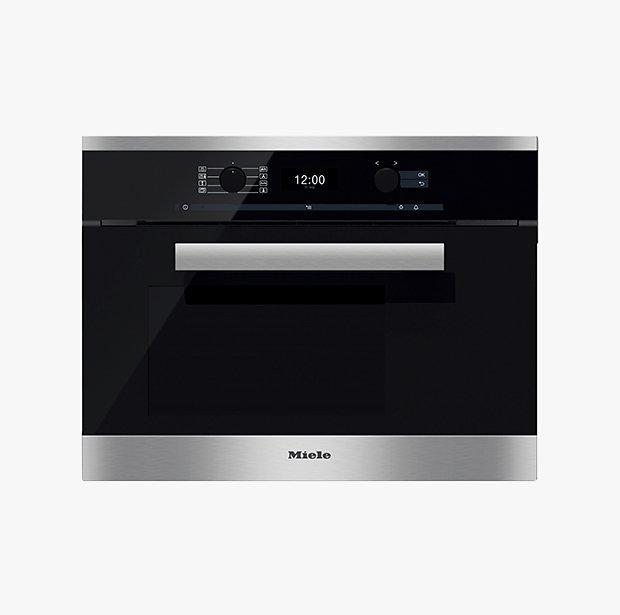
Oven Aids
- Fast preheat function switches all the elements on in order to heat up the cooking compartment particularly quickly
- Temperature probe makes precise cooking possible. It measures the temperature inside the food. Once the set temperature has been reached, the appliance automatically switches itself off
- Telescopic runners allow baking trays, roasting tins and ceramic oven dishes to be pulled clear of the oven interior. Useful for basting meat or turning food without transferring ovenware to the worktop
- Slide and Hide doors make it easier and safer to access the oven cavity
- Soft-close doors are a feature on some ovens - useful when your hands are full
- Plate warming ensures your ovenware, dishes and plates are ready to serve food from
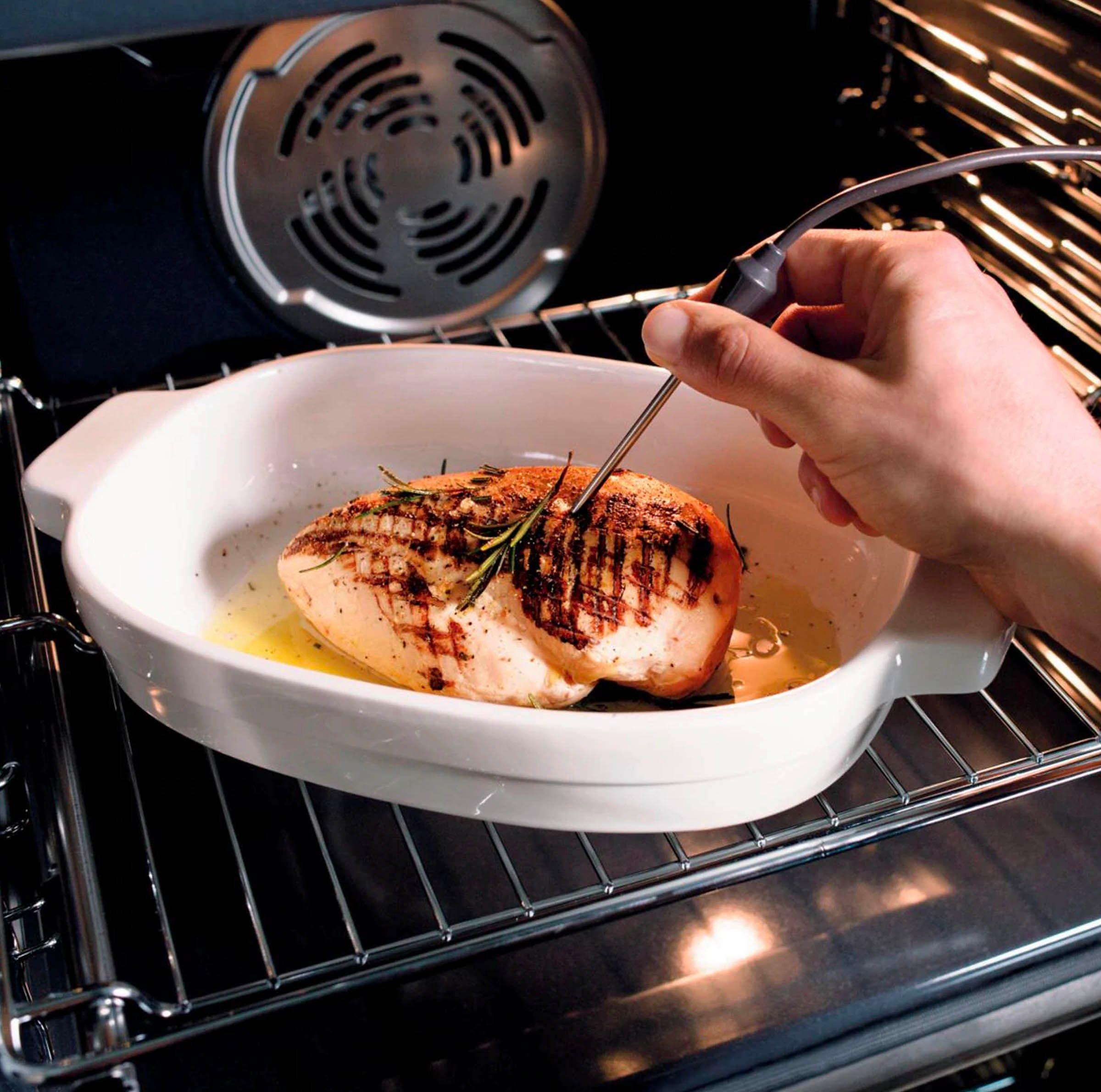
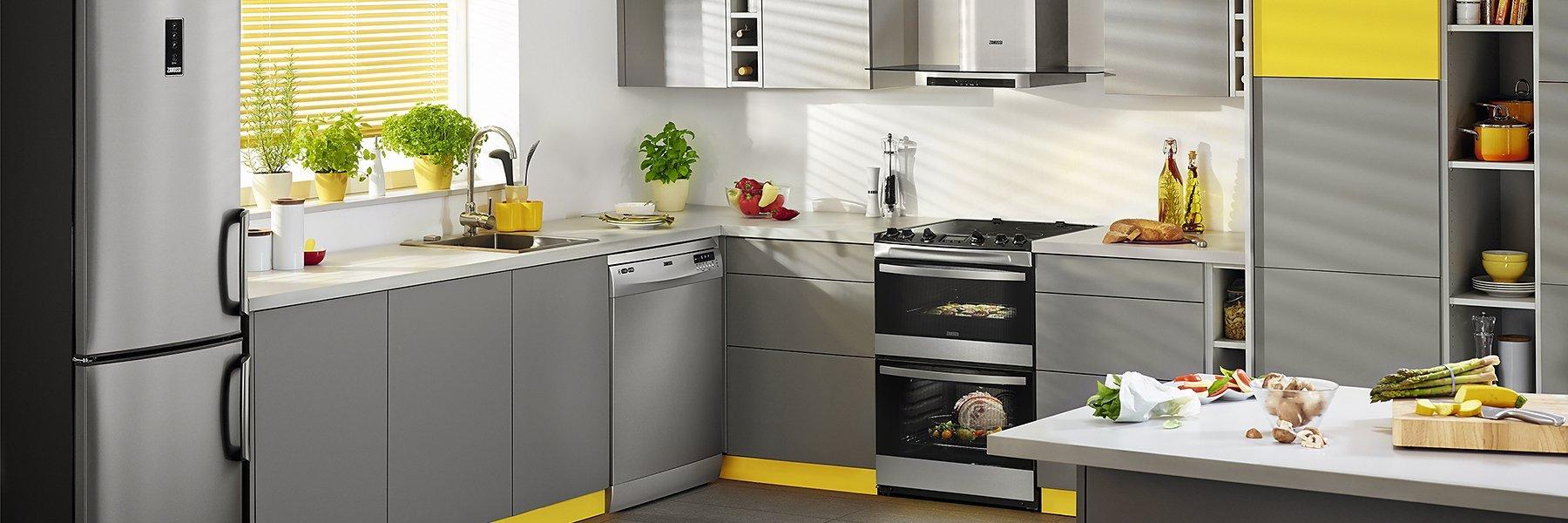
Oven and cooker features
Grills
- Some have both inner and outer elements
- If you’re cooking small food portions you can just use the inner element
- Some have variable controls so you can set the cooking temperature
- Simply raise or lower the grill pan to control the temperature in fixed grills
- High speed grills heat up faster, therefore they speed up cooking and save energy
- In most modern ovens the grill is used with the door closed
Electronic Controls
- These provide greater accuracy and maintain a constant temperature
Ideal for baking delicate foods
On some ovens, there are pre-selected temperatures to save you time
A meat thermometer is available in some ovens - it can measure the core temperature of meats so you know exactly when your meat is cooked. The thermometer is connected to a metal probe, which is inserted (at least two inches) into the thickest portion of the uncooked meat, well away from any fat, bone or cooking pan. This type of thermometer can remain in the meat while roasting in the oven or cooking on the grill
Timers
The simplest timer is the minute minder
An auto timer allows you to start and finish cooking at preset times
Usually only the main oven in a double oven is programmable
If you can set the timer for both ovens, it needs to be for the same length of time
You can also buy gas ovens with preset cooking times
Cleaning method
- Manual cleaning will require good old-fashioned elbow grease in conjunction with a cleaning agent (either natural or chemical) to remove burnt on deposits from the enamel interior of the oven.
Assisted cleaning lightens the cleaning load by using the heat of the roast to burn off any fat or grease that has soiled special catalytic panels that line the oven. The only cleaning required will be the areas not covered by these liners - generally the floor and rear wall of the oven.
Top of the range ovens use a high temperature self-cleaning pyrolytic setting, which cleans every part of the oven's interior. Use self cleaning on your oven every few weeks if you use your oven regularly. During the cleaning cycle the oven temperature rises to 500ºC and any soiling in the oven is carbonised and falls to the floor of the oven as ash with a datalytic converter in the oven roof neutralising the smoke created. The process takes 2-3 hours and when the oven cools down, it only needs a quick wipe away any of the resultant ash.
Safety Features
- Some ovens offer child locks for added safety
Self-cleaning ovens will have up to 4 layer of glass, keeping the outer layer of glass safe to touch during the pyroltic cleaning cycle. The door remains locked also, so it's impossible to access the oven while cleaning is taking place
Gas cooker manufacturers are legally obliged to fit their units with a flame failure device - this ensures that if the flame fails, the gas will turn off
Warming Drawers
Available to pair with built-in ovens
As the name suggests, they keep food or crockery warm but can also defrost
Especially useful if you entertain a lot and struggle with oven space
Doors
- Soft-close doors are a feature on some ovens - useful when your hands are full
Some NEFF ovens have a Slide & hide door that gives you easier and safer access to the oven cavity
A few ovens are available with side opening, which can be useful in particularly tight kitchen spaces
Some ovens offer child locks for added safety
Oven doors are detachable for easy cleaning
Hobs
Hobs that are 60cm wide and have 4 burners are the most common size
We also sell 5-burner 70cm models
These can still fit into a 60cm gap by overlapping the work surface
We also sell a range of 80cm and 90cm hobs
The most popular configuration of burners (or zones on a ceramic hob) is one large, two medium and a simmer
Some hobs now have specialist burners for fish kettles or for woks
The aperture dimensions we give to house the hob is smaller than the hob itself, as the hob overlaps and stands proud of the work surface
We recommend the size and rear space around a hob is about 5cm
Find out more about our hob installation service and what to check before booking
Hob Types
Induction Hobs
A popular variant of a ceramic hob
Cooking by induction is very effective with instant, precise and even heat
They use clever technology that heats the saucepan rather than the actual hob plate, this makes cooking fast and responsive
They’re usually more expensive
Quicker and more controllable than gas, and cheaper to run than other electric hobs
You'll need special saucepans with ferrous iron content to make them magnetic
Suitable pans include: enamelled steel, iron, stainless steel (depending on the alloy) and some aluminium pans with a ferromagnetic base
You won't be able to use glass or copper bases
If you have a heart pacemaker, do seek advice from your doctor before using an induction hob
Ceramic Hobs
Have a touch glass surface with heating elements beneath
These elements come in various forms - the faster they work, the more expensive the hob
Heat is conducted through the glass into the pan only
Easy to clean and some are operated by finger touch controls
Some have sensors which will turn down or cut off the heat automatically
Some have timers so that you don't need to return to the hob to switch off the heat
All hobs have residual heat lights so you can see when it's cool enough to touch
Gas Hobs
- Remain popular because the heat is visible, fast and easy to control
- Most have mains rather than battery ignition
- Some have automatic ignition so the burner ignites as you turn the knob
- With other types you’ll need to press and hold an ignition button as you turn the knob
- Some automatic ignition hobs have the benefit of reignition if the burner is blown out
- Others have flame failure cut-out, which turns the gas valve off if the flame is blown out
Electric Sealed Plates
Give a traditional look
They are relatively inexpensive and provide excellent heat distribution across the base of the saucepan
Because they conduct all the heat into the pans they’re cost-effective to run
Some have red spots which provide more power than equivalent size standard plates
Sealed plates can accommodate any type of flat base saucepan
They’re especially suited to cast iron cookware
Domino Hobs
They get their name from their distinctive oblong shape
They’re 30cm wide and feature one or two burners which can stand alone
By installing several different types of unit adjacent to each other, you can create a flexible and versatile cooking hub
You can add a single domino next to your standard hob, such fitting a wok burner domino next to your regular-sized electric induction hob
A boiling ring is great for locations where you might not want to install a full-size cooker
For example, a bed-sit or studio flat
They’re a good solution if you need extra hob capacity over and above what your current cooker provides
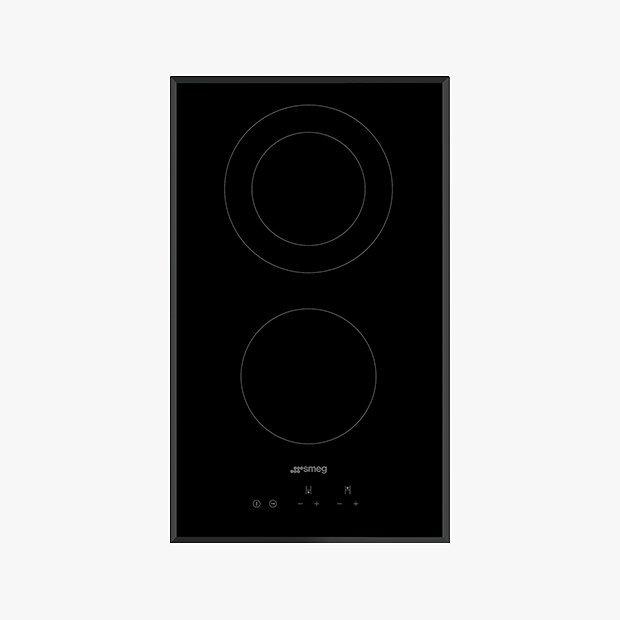
Cooker Hoods
Sealed heating systems, double glazing and insulation all stop the circulation
of fresh air, so a cooker hood helps get rid of moisture and odours caused by cooking.
Most of the cooker hoods we sell can either extract air or filter it.
Generally, the more you pay, the quieter and more energy-efficient the cooker hood will be.
Extraction
- The best option if you have space and capacity for ducting
- Steam and odours are removed from the kitchen to the outside of your house
Pros
- Removes airborne contamination such as smoke and odours
- Cheaper long term, as you don’t need to replace charcoal filters regularly
- The airflow rate is higher as there’s no charcoal filter in front of the motor
- Steam and odours are removed from the kitchen to the outside of your house
Cons
- Extraction isn’t possible in all kitchens, usually due to a lack of space or capacity to install ducting - for example, if your kitchen doesn’t have an external wall
- Ducting and installation are more expensive initially
- Ducting kits aren’t supplied with cooker hoods, but you can get them from the supplier or from a good DIY store
Filtration
Air is taken through two filters - a grease filter and a charcoal filter
The charcoal filter removes smoke and odour from the air before the hood releases the ‘scrubbed’, de-greased air back into the kitchen
All cooker hoods come with a grease filter, but not usually a charcoal one
Pros
- You can use a filtration hood pretty much anywhere – ideal if you can’t reach an outside wall with ducting
- Cheaper upfront as ducting is not required
- If the grease filter is paper it can be replaced and if it’s a permanent metal filter you can wash it in the dishwasher
Cons
- Recirculates some heat and moisture back into the kitchen
- You’ll need to buy a new charcoal filter once a year (through the manufacturer's’ websites or a dedicated spares shop)
- There’s decreased airflow rate because the charcoal filter is in front of motor
- You may also need a recirculation kit to ensure that odour-free air is returned into the kitchen
Ducting
- Sometimes you can choose between 150mm or 120mm (with an adaptor collar) ducting
- Opt for the wider ducting if your builder approves, as this will offer a slightly improved airflow rate
- Rigid ducting will also offer better airflow than flexible ducting, because the ridges on the latter slightly inhibit the flow of the exhaust air
To work out the extraction rate you need for your kitchen
- Calculate the volume of the room in cubic metres by multiplying length x width x height
- Multiply that figure again by 12 (for the recommended 12 changes of air per hour)
- The final figure is the minimum extraction rate you need from your cooker hood
Style
Cooker hoods will always contain lamps to illuminate your hob and work surface.
We sell a variety of cooker hood styles such as:
Visor Style
Similar to a canopy style, but mounted to the wall instead.
Downdraft Style
Hidden in your worktop and at the touch of a control, rises when you need it.
Tip
Whichever style you choose, you'll need to position the hood correctly at a minimum of:
75cm above a gas hob
65cm above an electric hob
Remember to check manufacturer’s recommendations before you install
Energy Efficiency
Energy efficiency gradings for electric ovens are the responsibility
of the appliance manufacturers and their work is monitored by Trading Standards.
Standard tests are carried out by heating a brick, and efficiency
gradings of A+++ - G applied, with A+++ being the most efficient.
Although energy efficiency labels are currently unavailable for hobs, induction hobs feature cooking zones which automatically recognise the pan size for heat efficient cooking. They also have an energy consumption display so you know just how much energy you’re using.
Ordering
What are my delivery options?
Standard delivery of your cooking appliance is free. This can be in as little as 3 working days, but you’ll be offered delivery slots at checkout.
We also offer next and named day delivery for an additional fee.
Delivery by our approved supplier means your appliance will be delivered directly by the manufacturer, or their chosen courier, and they will arrange delivery with you.
Cooking Appliance Installation Services
Integrated 13 or 32 Amp Oven - £115
Integrated 16 or 20 Amp Oven - £130
Electric or induction hob - £115
Disposal - £25 per appliance
If your new cooking appliance is being delivered by our Partner van fleet, and is not gas or dual fuel, we can install it and take away your old one. There are some terms and conditions attached to these services, so please check these below..
Installing the Cooking Appliance Yourself
We recommend:
Electric ovens and cookers are connected to a separate 30 or 45 amp supply
You avoid running single ovens from a 13 amp supply to ensure the ring main circuit is not overloaded
Connecting them to the fitted cooker circuit using a large sized 13 amp fuse
That all cookers are installed by a registered engineer
Please note that connection cables are not supplied with electric cookers.
Gas Appliances
We recommend:
All gas appliances are installed by a Gas Safe Register-registered engineer
Please note that connection hoses don’t come with gas cookers. Also, all manufacturers of gas cookers are legally obliged to fit their units with a flame failure device - this ensures that if the flame fails, the gas will turn off.

Guarantees
Guarantees on all our cooking appliances are at least 2 years as standard.
John Lewis cooking appliances have 3-year guarantees.
PARTNERSHIP CARD
Our rewards credit card gives you 1.25% back in points towards vouchers when you shop with us.


PARTNERSHIP CARD
Our rewards credit card gives you 1.25% back in points towards vouchers when you shop with us.
John Lewis plc, 171 Victoria Street SW1E 5NN acts as a credit broker. Credit provided under exclusive arrangements with the lender John Lewis Financial Services Limited

